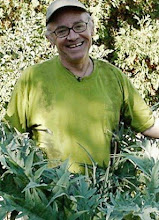The new hoop house, season extender, is up and planted. The total cost is somewhere less than a $100 as I did have some materials left from other projects that I used. I got gray PVC conduit instead of the white plastic because it cost less than the other pipe and I liked the fact that I did not have to buy another fitting to stick them together - the conduit has male and female ends for gluing purposes.
I used the ten foot conduit and only cut about 6-7 inches off each end to make a hoop that was 74 inches high and fit nicely between my 2x4 base frame. I used rebar rods and galvanized 'U' straps at the base to secure the hoops to the frame. I used 1x2 furring strips as side and top braces and attached them to the pipe with zip ties. The ends were each different as I wanted to see which seemed to work best for closing off the hoops. I think I like the front closure method better than the rear closure for two reasons - first, the front does not need another piece of pipe and it was difficult to get the bend correct to fit under the existing pipe at the rear; second, the front seems more stable and has more staple points for attaching plastic. Both ends are from other Internet sites that show this kind of plastic hoop house.
(Look at them here: doorgarden.com/10/50-dollar-hoop-house-green-house and also at www.albertahomegardening.com/how-to-build-an-inexpensive-hoop-style-greenhouse )
I used one 20ft x 25ft sheet of 3 mil plastic to cover the house. What I liked was that this plastic sheet allowed me to double the covering - (not planned but it just turned out that way - what luck) - so I think the structure will better withstand snow and maybe allow the snow to slip off better. The plastic was secured to the base with lath strips and dry wall screws. Snow was the biggest problem with the old structure I had - snow stayed on the roof and had to be pushed off. We will just have to wait and see what winter will bring to this season extender.
So to summarize - the new hoop house is a 10 ft x 10 ft space with 2x4's as anchors for the two pieced PVC conduit hoops. The braces are 1x2x8 and the end boards are 1x3's. The door is also 1x3's and is covered with a sheet of heavy plastic I have been using to make apple labels. A friend gave me several sheets of this stuff a long time ago and so out of the basement the heavy plastic came to serve as a nice door for the hoop house - (Thanks Linda L.) The skin is a 20x25ft sheet of 3 mil plastic and the ends are covered with pieces from an 8x25 sheet of 4mil plastic. The whole structure was secured with zip-ties and drywall screws.
The only thing I forgot to do was to paint the PVC as some discussion says the plastic against plastic seems to degrade. So I put duct tape on the hoops after the fact today and will wait to see how that works.
The space has some plants already in place - celeriac and some greens but today I planted spinach, lettuce, greens, and some kale seed I had left from last year. I also left some space for arugula and lettuce for a spring planting. Hopefully the weather will hold and I will get some germination in the next two weeks. The spinach I planted in the cold frame a while ago is sprouted and the lettuce transplants have perked up too.
Along with finishing and planting the hoop house I got some of the other fall jobs done. I drained all the rain barrels; dug the bonsai into their winter locations; picked the apples - mainly because the robins are attacking the fruit through the bags. I had a number of apples that were really pecked badly and that allowed the German wasps to get on them too. So the best solution was to pick them all. I pulled all the tomato posts last week and hope to till the garden soon.
Happy Gardening
